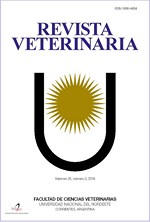Morphological abnormalities in nucleous of hematies from the fish Prochilodus linneatus exposed to clorpirifos
DOI:
https://doi.org/10.30972/vet.3024136Keywords:
Fish, Prochilodus linneatus, chlorpyrifos, erythrocytes, abnormalities, micronucleusAbstract
In recent years, the monitoring of xenobiotics (chemicals such as pesticides) in the environment has been very important, as the persistence of the biological activity of many of these compounds has been recognized. Chlorpyrifos is an organophosphorus insecticide of broad spectrum, used in agricultural and domestic activities. This pesticide as well as other chemicals may accidentally reach the aquatic ecosystem and the ictic fauna. Fish ingesting contaminated substances subsequently develop alterations due to bioaccumulation, becoming effective indicators of environmental pollution. The purpose of this study was to evaluate the genotoxicity of chlorpyrifos in P. linneatus (Pisces, Prochilodontidae) through the frequency of micronuclei (MN) and nuclear morphology alterations (AMN) in peripheral blood erythrocytes. After acclimatization the fish were divided into two control (C) and treated groups (T1 = 10 μg/l, T2 = 30 μg/l and T3 = 90 μg/l). Three replicates per group (C, T) were performed with a total of 3 animals per fishbowl. The animals remained in the aquariums for a period of 7 days. After this time they were sacrificed with an overdose of anaesthetic to extract blood from the caudal vein. Smears were stained with Giemsa. In the samples analyzed, the number of MN and AMN was determined after observation of 2000 cells per animal. Cells with intact cytoplasmic membrane were considered for the study. The analysis of blood smears in both groups revealed the presence of micronuclei and the following nuclear morphology alterations; notches, lobulated, evaginations, eigth shaped, segmentations and vacuolization nuclei. Individuals T3 showed significant variations in the frequency of MN and AMN with respect to the controls (p<0.05), but not the T1 and T2 specimens. We conclude that chlorpyrifos at a dose of 90 μg/l could be harmful to the environment.
Downloads
Downloads
Published
How to Cite
Issue
Section
License
Copyright (c) 2019 C. S. Caramello, C. F. Cowper, M. J. Jorge, J. E. Pérez, L. C. Jorge

This work is licensed under a Creative Commons Attribution-NonCommercial 4.0 International License.
Revista Veterinaria (Rev. Vet.) maintains a commitment to the policies of Open Access to scientific information, as it considers that both scientific publications as well as research investigations funded by public resources should circulate freely without restrictions. Revista Veterinaria (Rev. Vet.) ratifies the Open Access model in which scientific publications are made freely available at no cost online.











.jpg)
.jpg)



